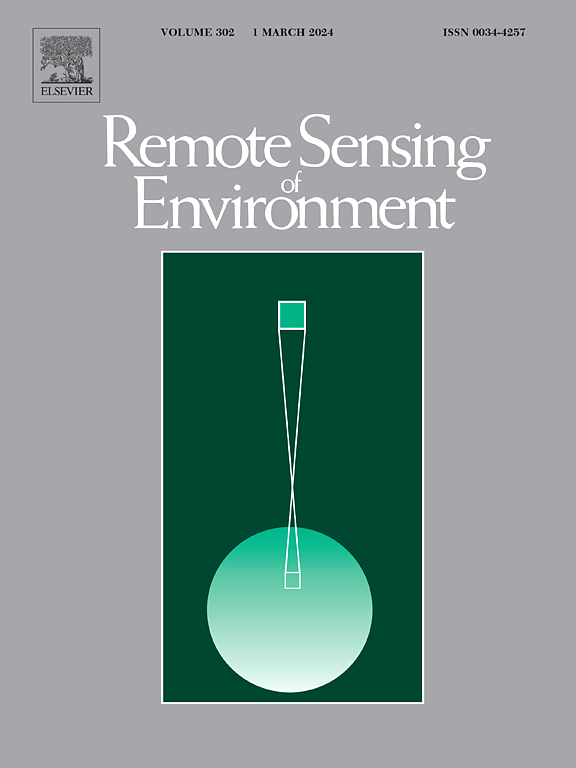Joint utilization of closure phase and closure amplitude for soil moisture change using interferometric synthetic aperture radar
IF 11.1
1区 地球科学
Q1 ENVIRONMENTAL SCIENCES
引用次数: 0
Abstract
The sensitivity of microwave data in soil moisture is attributed to radar wave penetration depth and signal attenuation. However, current soil moisture models rarely consider the simultaneous effects of amplitude and phase induced by soil moisture. This study proposes an innovative InSAR Bias Soil Moisture Model (IBSMM) that jointly exploits closure phase and closure amplitude. Compared with traditional models, IBSMM considers the dual physical change process of microwave signals in soil moisture change. The IBSMM includes a three-step framework to estimate soil moisture. First, conventional repeat-pass InSAR datasets are generated. Second, the bias in closure characteristics is estimated using Regularized Maximum Likelihood Estimation (RMLE) and a dynamic nested sampling strategy. Third, a forward model for soil moisture change is constructed based on the backscattering field. The simulation results indicate that the dynamic nested sampling strategy has a deviation of only 0.042 from the logarithm evidence value. Moreover, the insensitivity and saturation thresholds in the soil moisture model are quantified. Subsequently, the results of two practical case experiments in different land cover types confirm the effectiveness of IBSMM. In Castrejón de Trabancos, Spain, from January 12, 2020 to February 5, 2020, the model had an overall average correlation coefficient (R value) of 0.57 and a root mean square error (RMSE) of 3.39%. Similarly, in Guyuan County, China, from October 5, 2018 to October 29, the model recorded an average R value of 0.46 and an RMSE of 3.1% in grassland. The proposed IBSMM effectively enhances soil moisture estimation accuracy and explains the physical process of soil moisture change.
干涉型合成孔径雷达合拢相位和合拢幅值对土壤水分变化的联合利用
土壤湿度微波数据的敏感性主要受雷达波穿透深度和信号衰减的影响。然而,目前的土壤湿度模型很少考虑土壤湿度引起的幅值和相位的同时影响。本文提出了一种联合利用闭合相位和闭合幅值的InSAR偏差土壤水分模型(IBSMM)。与传统模型相比,IBSMM模型考虑了土壤湿度变化中微波信号的双重物理变化过程。IBSMM包括一个估算土壤湿度的三步框架。首先,生成常规的重复通过InSAR数据集。其次,使用正则化最大似然估计(RMLE)和动态嵌套采样策略估计闭合特征的偏差。第三,建立了基于后向散射场的土壤水分变化正演模型。仿真结果表明,动态嵌套采样策略与对数证据值的偏差仅为0.042。此外,还对土壤水分模型的不敏感阈值和饱和阈值进行了量化。随后,两个不同土地覆盖类型的实际案例试验结果验证了IBSMM的有效性。在西班牙Castrejón de Trabancos, 2020年1月12日至2020年2月5日,模型总体平均相关系数(R值)为0.57,均方根误差(RMSE)为3.39%。同样,在中国固原县,2018年10月5日至10月29日,该模型在草地上的平均R值为0.46,RMSE为3.1%。提出的IBSMM有效地提高了土壤水分估算精度,解释了土壤水分变化的物理过程。
本文章由计算机程序翻译,如有差异,请以英文原文为准。
求助全文
约1分钟内获得全文
求助全文
来源期刊

Remote Sensing of Environment
环境科学-成像科学与照相技术
CiteScore
25.10
自引率
8.90%
发文量
455
审稿时长
53 days
期刊介绍:
Remote Sensing of Environment (RSE) serves the Earth observation community by disseminating results on the theory, science, applications, and technology that contribute to advancing the field of remote sensing. With a thoroughly interdisciplinary approach, RSE encompasses terrestrial, oceanic, and atmospheric sensing.
The journal emphasizes biophysical and quantitative approaches to remote sensing at local to global scales, covering a diverse range of applications and techniques.
RSE serves as a vital platform for the exchange of knowledge and advancements in the dynamic field of remote sensing.
 求助内容:
求助内容: 应助结果提醒方式:
应助结果提醒方式:


